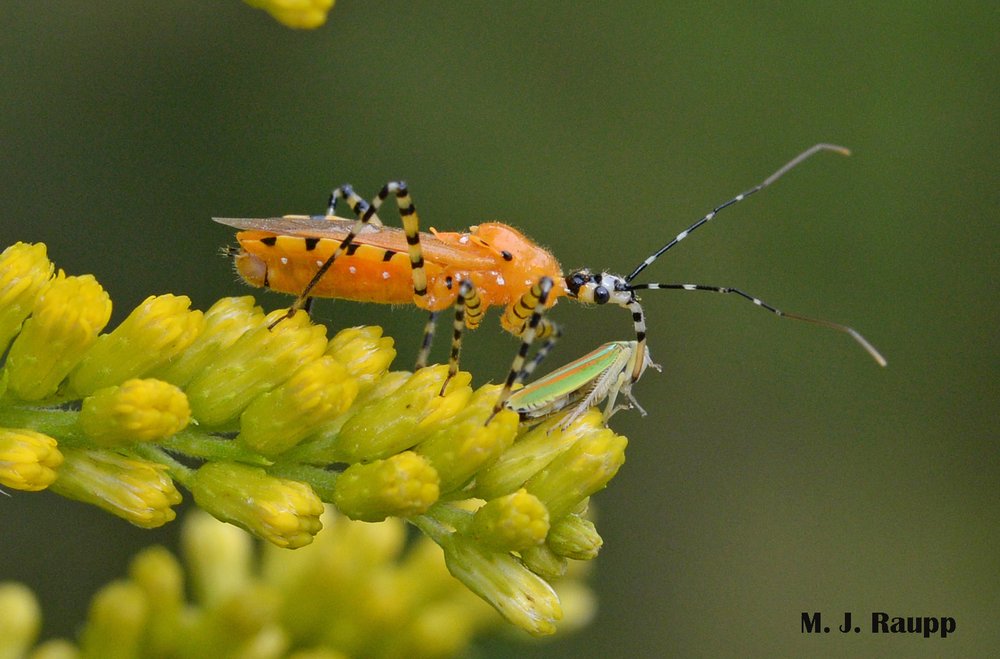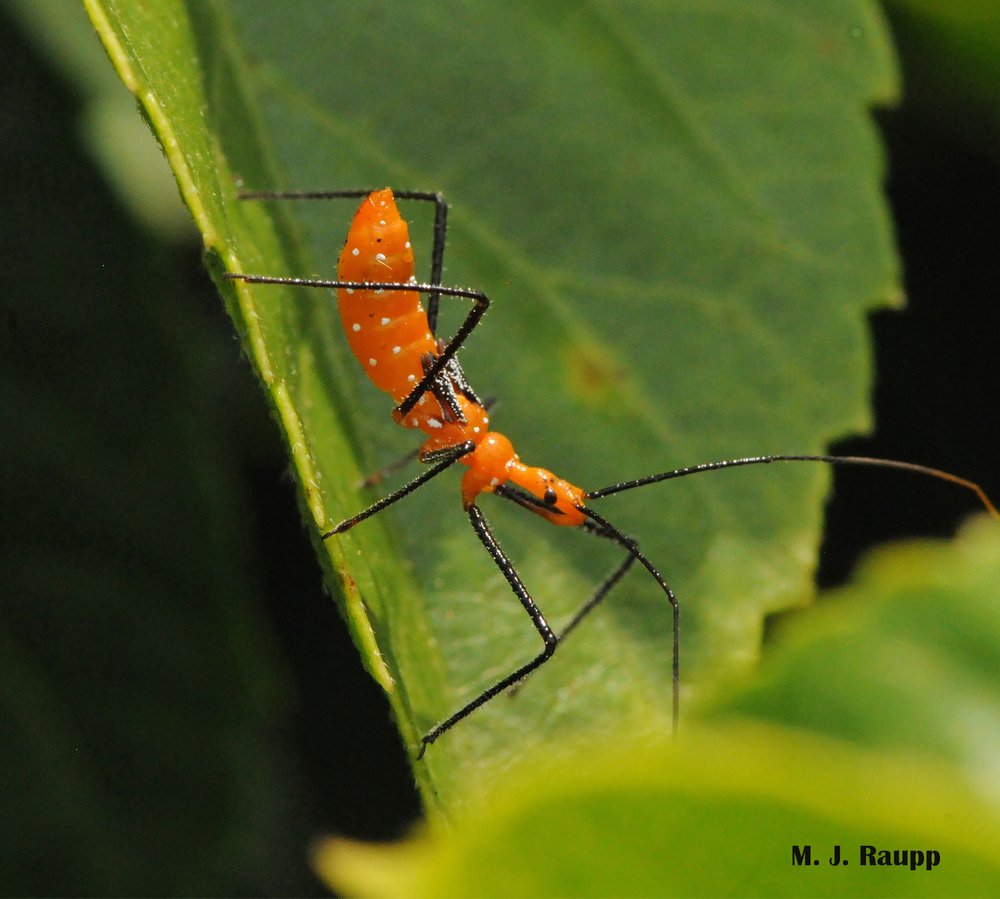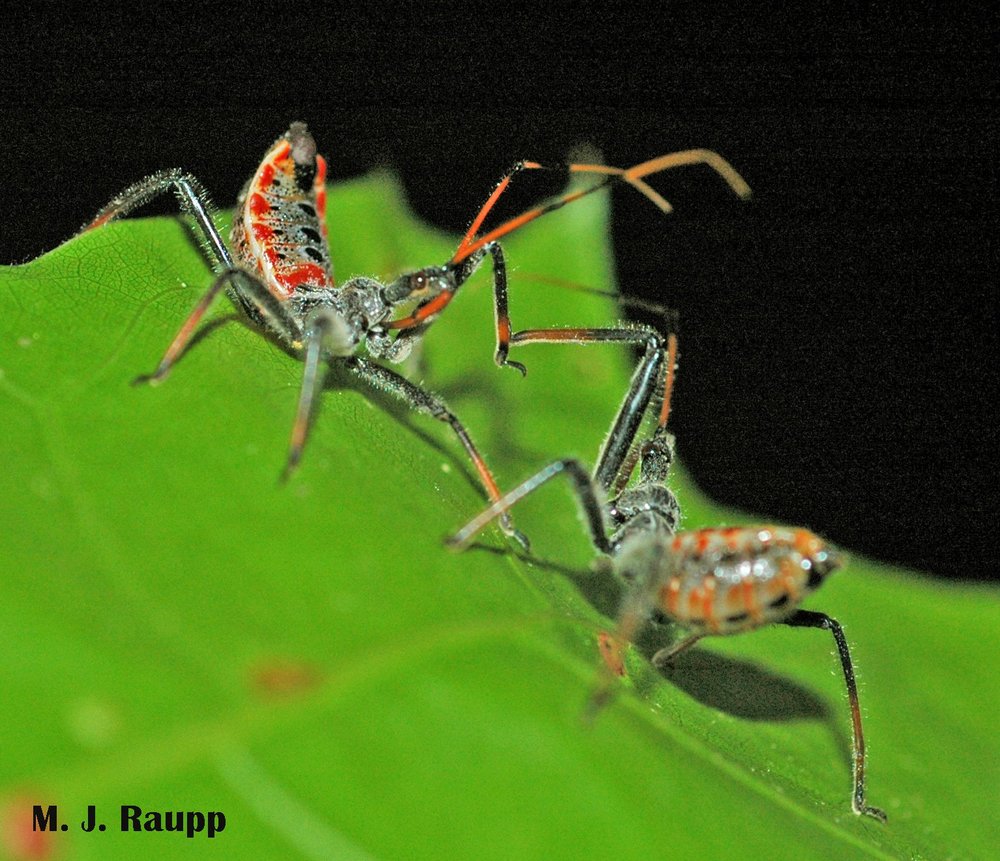Bugs in orange and black – Three spooky assassins: milkweed assassin bug, Zelus longipes; orange assassin bug, Pselliopus barberi; and wheel bug, Arilus cristatus

This orange assassin bug wearing black jailhouse stripes delivered a trick, not a treat to a hapless leafhopper.
In keeping with a Bug of the Week tradition of visiting bugs dressed in orange and black to celebrate Halloween, All-Saints Day, and Día de los Muertos, what could be creepier than meeting three terrifying assassins? In the lexicon of entomology, the term ‘true bug’ identifies a large and important order of tens of thousands of insect species known as the Hemiptera. True bugs are characterized by their sucking mouthparts and incomplete metamorphosis consisting of egg, nymph, and adult stages. Many true bugs are plant feeders, including harlequin bugs, squash bugs, stink bugs, and bed bugs we met in previous episodes, but many are fierce predators playing an important role annihilating pests of crops and ornamental plants. This week we visit three murderous members of the true bug clan in the family known as Reduviidae, or assassin bugs, that dress in the colors of the season – orange and black. Orange and black are Mother Nature’s warning colors, usually sending the signal to predators “don’t mess with me”! Like monarch butterflies and milkweed leaf beetles, maybe these assassin bugs have a nasty flavor by virtue of chemical protectants.

Sticky forelegs help the milkweed assassin bug snare its prey.
The first bug I bumped into was the milkweed assassin bug, owner of a diabolically clever strategy for catching its prey. Hiding in foliage with its forelegs outstretched, it awaits the approach of an unsuspecting victim. The front legs of this assassin bug are coated with sticky goo (a technical term) perfect for snaring a victim. Once captured, the prey is impaled with a hungry beak that injects proteolytic enzymes. The predigested and liquefied contents of the prey are then sucked into the digestive tract of the assassin bug with the aid of a tiny muscular pump in the assassin bug’s head.
Nearby, in a patch of goldenrod, another snatcher of lives, the orange assassin bug, stalked its victims. I watched this stealthy assassin move slowly about a goldenrod blossom. A short while later, I saw this assassin with a small leafhopper skewered on its beak. How it was able to sneak up and stab a highly mobile and wary leafhopper is known to the assassin bug but is a mystery to me.
Watch as a juvenile milkweed assassin bug takes a wild ride on a hibiscus plant. Note the black wing buds on its back. At the next molt, these will develop into pairs of jet-black wings as seen on this camera-shy adult. Nearby, on a goldenrod flowerhead an orange assassin bugs hunts. Soon, a hapless leafhopper meets its doom at the end of this spooky predator’s beak.
The third amigo in this triad of terror is the large assassin bug known as the wheel bug. We met wheel bugs and learned of their important role as biological control agents of the brown marmorated stink bug in previous episodes of Bug of the Week. In addition to dining on invasive pests including brown marmorated stink bugs, this generalist predator has a taste for native protein sources including several types of caterpillars. To see what I mean, watch the YouTube “Wheel bug stalks caterpillar”, the most watched video in the Bug of the Week ensemble, a short snippet of which is included in this week’s episode: https://www.youtube.com/watch?v=6bfUpaaEKcQ

What does it mean when wheel bug nymphs give each other a high five?
In autumn the female wheel bug deposits clusters of barrel-shaped wheel bug eggs on the bark of many types of trees. The following spring when prey return to pester plants, the eggs hatch into gorgeous orange nymphs. The thorax of nymphs soon changes from orange to black, but as nymphs grow and molt a reddish-orange color is retained on the abdomen. Like other assassin bugs, the business end of the wheel bug is the powerful beak, or proboscis, stored between the beast’s front legs when it is not in use. Upon spying a tasty morsel, the wheel bug cautiously approaches, embraces the prey with long front legs, and then impales the victim with its powerful beak. The wheel bug pumps strong digestive enzymes through the beak into the prey. These enzymes liquefy the body tissues of the hapless victim. A muscular pump in the head of the bug slurps the liquefied meal up through the beak. If a string of unusually warm autumn weather prevails, dash to the meadows and you may have a chance to observe one of these beautiful and deadly assassins prowling for prey on the Day of the Dead.
Tiny wheel bug nymphs enter the world orange and yellow but soon the head and thorax darken to black. An older nymph grabs an ill-fated lightening bug and prepares to drain the beetle’s blood with its impressive beak. Nefarious pests including brown marmorated stink bugs and pesky fall webworm caterpillars fall victim to this assassin and even bristly spines of a smartweed caterpillar can’t save it from this terrifying predator.

Bug of the Week wishes everyone a spooky, fun-filled, and safe Halloween week!
Acknowledgements
The informative publication “Milkweed assassin bug (suggested common name) scientific name: Zelus longipes Linnaeus (Insecta: Hemiptera: Reduviidae)” by Megha Kalsi and Dakshina R. Seal was used to prepare this episode.
This post appeared first on Bug of the Week